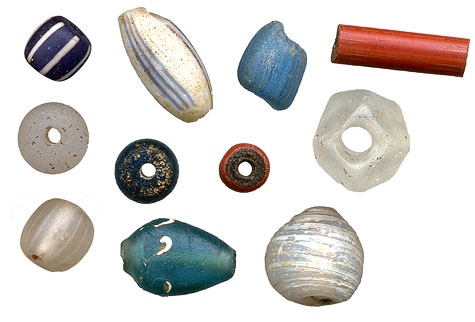|
|  |
 |
 |
 |
| Glass Beads |
 |
| Glass beads made in Italy and Holland were widely circulated in the Americas. The larger beads were probably worn in necklaces, and the very small beads were probably sewn onto various articles of clothing. Dr. Diana DiPaolo Loren has discussed the role of dress in social identity formation, and suggested that beads played a part in the creation of new social identities at Los Adaes. [see Loren 1996 Colonial Dress at the Spanish Presidio Los Adaes, Southern Studies, 7(1):45-64] The larger beads are called “wound” beads, because the glass is wound around a wire and shaped when molten. “Drawn” beads are made by drawing a molten gob of glass with an air bubble in the middle. The gob is stretched and the resulting tube of glass is broken to the desired length of the bead. The sharp, broken edge is smoothed by reheating. Lines of tiny bubbles parallel to the hole of the bead are visible in “drawn” beads. The tubular bead has a length of 1.3 cm and a diameter of 0.47 cm. |
 |
Photo credit: Don Sepulvado
Source: Williamson Museum, Northwestern State University, Natchitoches, Louisiana |
 |
|  |
|
